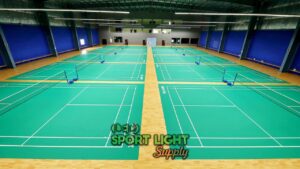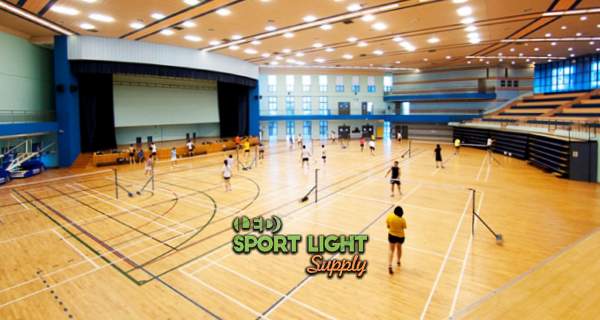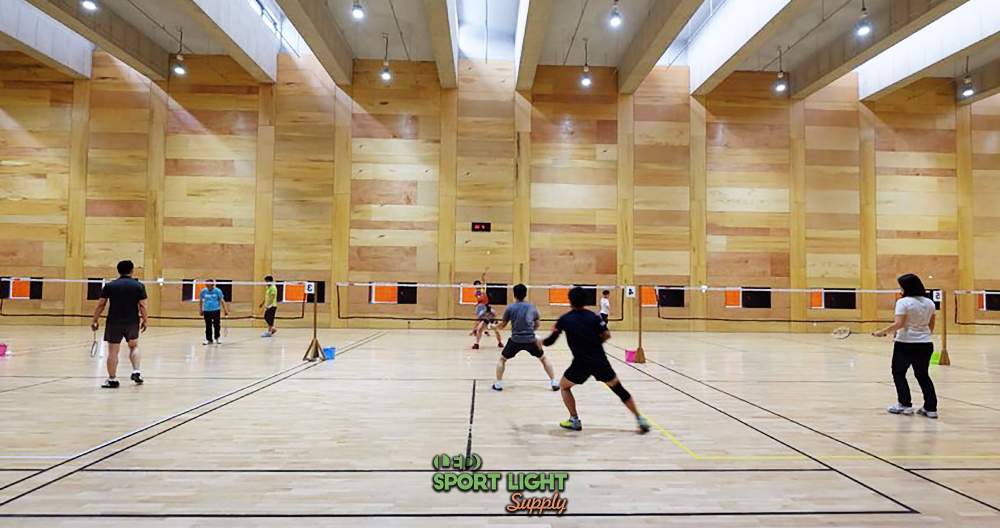
Recreational courts typically need around 300 lux to provide clear visibility without excessive brightness, while professional setups demand 750-1000 lux for high-speed action and precise perception. Factors like even light distribution, minimized glare, and the right color temperature enhance both player focus and spectator enjoyment. By implementing thoughtful lighting strategies—including energy-efficient LEDs and optimal fixture placement—venues can create an environment that supports peak performance and comfort for all.
Table of Contents
Toggle The recommended illumination levels for badminton courts vary depending on the setting. In recreational environments, a light level of approximately 300 lux is generally considered adequate. This level of brightness enables players to see the shuttlecock and the court clearly without creating excessive glare or unnecessary brightness. A light level around 300 lux offers a comfortable experience for both casual players and those playing in local or community sports facilities.
The recommended illumination levels for badminton courts vary depending on the setting. In recreational environments, a light level of approximately 300 lux is generally considered adequate. This level of brightness enables players to see the shuttlecock and the court clearly without creating excessive glare or unnecessary brightness. A light level around 300 lux offers a comfortable experience for both casual players and those playing in local or community sports facilities.
For professional or competitive play, lighting requirements are more precise and demanding. Courts used in professional tournaments typically require illumination levels between 750 and 1000 lux. This enhanced level of lighting ensures that players can accurately judge the shuttlecock’s position, even at high speeds. Higher illumination is also advantageous for spectators, allowing them to follow the game comfortably. Broadcast-quality lighting ensures that television viewers experience clear visuals, as cameras capture every motion of the shuttlecock and player movements with clarity.
Multi-use sports facilities that host both recreational and professional badminton matches should consider lighting systems that allow for adjustable illumination levels. Many modern facilities employ LED lighting systems with dimming capabilities, allowing the light intensity to be altered according to the event. This flexibility supports both general use and high-profile tournaments, maximizing the venue’s functionality while keeping energy costs under control.
Uniformity in lighting is a significant aspect of badminton court illumination, as uneven light distribution can affect players’ depth perception and overall performance. The lighting should be spread evenly across the court to prevent any sections from appearing overly bright or too dim. Uneven lighting can create zones of distraction, which may impair players’ ability to track the shuttlecock accurately.
To achieve consistent light levels across the playing area, the uniformity ratio is calculated. This ratio compares the average illumination to the minimum illumination found on the court. An ideal uniformity ratio for badminton courts is around 1.5:1 or lower, meaning the difference between the brightest and dimmest areas is minimal. Achieving a low uniformity ratio prevents shadowed spots or glare patches, ensuring that players experience a balanced lighting field from every angle on the court.
Ensuring uniform lighting involves strategically positioning fixtures and adjusting their angles to create a consistent spread of light. Fixtures are typically placed at specific intervals and heights to ensure overlapping light beams, which helps to minimize areas of intense brightness or shadow. In many cases, using LED fixtures aids in achieving uniformity, as LEDs can be angled and positioned with high precision. Advanced lighting simulations can be conducted to determine the best arrangement, especially for larger or irregularly shaped sports facilities that require optimal light distribution.

The color temperature of the lighting plays a significant role in how well players and spectators perceive the playing area. Color temperature, measured in Kelvin, determines the warmth or coolness of the light, impacting the clarity and ambiance of the environment. For badminton courts, a color temperature range of 4000 to 5700 Kelvin is generally recommended.
The 4000-5700 Kelvin range closely resembles natural daylight, which offers several advantages. First, this color temperature creates a clear and vibrant visual environment, which helps players focus on the shuttlecock and its movements without straining their eyes. Second, daylight-like color temperatures enhance contrast, allowing players to better distinguish the shuttlecock against the court and surrounding areas. This can be particularly beneficial during intense, fast-paced games where the ability to track small, high-speed objects is crucial.
Lighting within the recommended color temperature range can significantly reduce eye strain, especially during prolonged games or practice sessions. Cooler color temperatures in the 4000-5700 Kelvin range reduce glare and reflection on the court’s surface, creating a softer, more visually comfortable atmosphere for players and spectators alike. LED lighting technology often provides options for adjustable color temperature, which can be fine-tuned to achieve the ideal setting based on specific tournament requirements or preferences.
The placement and angle of lighting fixtures are integral to achieving optimal visibility on the badminton court. The goal is to position lights in a way that illuminates the entire court evenly while avoiding direct glare in the players’ eyes. Additionally, appropriate fixture placement prevents the formation of shadows that could disrupt the flow of the game.
In most badminton facilities, lighting fixtures are mounted on the ceiling or placed high on the walls, allowing the light to disperse evenly over the court. Ceiling-mounted lights offer direct overhead coverage, while wall-mounted fixtures are angled to cover the court’s perimeter. This setup reduces the risk of dark spots along the edges of the court and minimizes the amount of light “spillover” outside the designated playing area. Fixtures are typically arranged in a symmetrical layout, ensuring consistent illumination regardless of the angle from which players approach the shuttlecock.
The angle at which lights are positioned significantly affects glare and shadow creation on the court. Lights should be angled carefully to avoid direct glare, as players looking upwards to track a high shuttlecock trajectory can be temporarily blinded by overly direct light sources. Angling lights at a slightly downward position, or using diffusers, can reduce this glare effect, allowing players to concentrate fully on the game without visual interruptions. Shadows are also minimized by positioning fixtures to allow light overlap, ensuring that no part of the court remains in shadow.
Choosing durable and energy-efficient lighting fixtures for badminton courts is essential for maintaining consistent lighting quality and managing energy costs. LED lights have become the preferred option for sports facilities, including badminton courts, due to their longevity, efficiency, and lighting quality.
LED lighting offers several advantages over traditional lighting options such as halogen or fluorescent lights. First, LEDs have an extended lifespan, often lasting up to 50,000 hours or more, which reduces the frequency of replacement and maintenance costs. LED lights also consume significantly less energy, lowering operational costs for the facility. This energy efficiency aligns well with sustainability goals, reducing the environmental footprint of sports venues.
Another benefit of LED lighting is its low heat emission. Unlike halogen or incandescent fixtures, LEDs remain cool even after extended periods of use. This characteristic contributes to a more comfortable environment on the court, as excessive heat can be distracting for players and can affect their performance over long sessions. Lower heat output also reduces the strain on a facility’s air conditioning system, adding to the cost savings associated with LED technology.
Maintaining lighting systems is essential to ensure consistent light quality and to preserve the playing conditions on the badminton court. Over time, dust accumulation, fixture misalignment, or bulb degradation can affect light quality and uniformity, making periodic maintenance a necessary practice.
Dust and dirt buildup on lighting fixtures can significantly reduce their brightness and efficacy. Regular cleaning of the fixture lenses or covers helps to maintain the intended illumination levels, keeping the court well-lit for players and spectators. Inspection of the fixtures for any signs of wear or damage is also recommended, as issues like cracked lenses or loose fittings can impact both lighting quality and safety.
While LED bulbs have a long lifespan, they may eventually dim or require replacement to keep the lighting at the desired levels. Replacing any faulty bulbs promptly ensures that the court maintains the required illumination levels. It is also essential to check the alignment of fixtures periodically, as vibrations or minor shifts over time can alter the fixture’s angle. Adjusting and re-aligning fixtures ensures that the light distribution remains uniform and that there are no unwanted shadows or glare patches on the court.
Establishing a preventive maintenance schedule helps sports facilities keep their lighting systems in optimal condition. Regularly scheduled maintenance, rather than reactive repairs, minimizes the risk of sudden lighting failures that could disrupt games or events. Preventive maintenance includes not only cleaning and bulb replacement but also periodic checks of electrical connections, fixture stability, and system settings. For facilities that host tournaments or events, it is particularly beneficial to conduct maintenance before major matches to ensure that lighting conditions meet professional standards.
Quality lighting on a badminton court is a combination of various elements working together to enhance the playing environment and spectator experience. By adhering to recommended illumination levels, maintaining uniformity, selecting appropriate color temperatures, optimizing fixture placement, and conducting regular maintenance, facilities can provide an exceptional lighting setup for recreational and professional players alike. LED technology has advanced the possibilities for efficient, durable, and high-quality lighting, creating an arena where players can focus on the game without distractions. By prioritizing these lighting principles, badminton venues can ensure a clear, safe, and enjoyable experience for everyone involved.
Drop us a line to receive a free lighting design